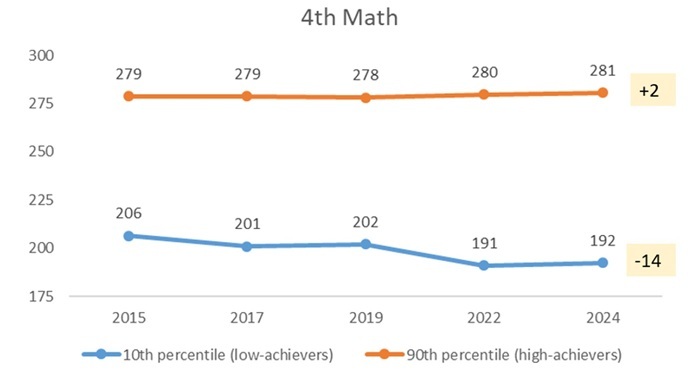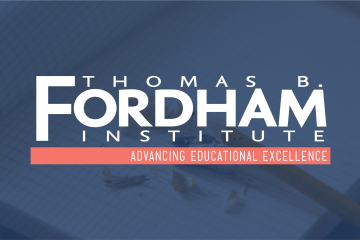NOTE: On February 11, 2025, the Ohio Senate Education Committee heard testimony on Senate Bill 19. It proposes increasing academic intervention services at public schools regarding student mathematics achievement and the establishment of improvement and intervention plans. Fordham’s vice president for Ohio policy provided proponent testimony on the bill. These are his full written remarks.
My name is Chad Aldis, and I am the Vice President for Ohio Policy at the Thomas B. Fordham Institute. The Fordham Institute is an education-focused nonprofit that conducts research, analysis, and policy advocacy, with offices in Columbus, Dayton, and Washington, D.C.
I am here today to testify in strong support of Senate Bill 19. This bill takes a crucial step toward ensuring that Ohio’s students—particularly those who are struggling the most—receive the support they need to succeed in mathematics and English language arts (ELA). It acknowledges the hard truth that far too many Ohio students are not on track for success. However, while SB 19 is a strong piece of legislation, we urge the committee to go even further, particularly in addressing the state’s alarming numeracy crisis.
Ohio’s Math Crisis and the Urgent Need for Action
The data tell a troubling story. The latest National Assessment of Educational Progress (NAEP) results reveal that Ohio’s lowest-performing students continue to fall further behind their peers in mathematics.[1] Since 2015, students at the 10th percentile in math have seen their scores drop precipitously—equivalent to losing more than a full grade level of learning. Meanwhile, their higher-achieving classmates have remained relatively stable, exacerbating achievement gaps that will have lifelong consequences.

This is a crisis as students who fail to develop foundational numeracy skills are at a severe disadvantage in the workforce and everyday life. Whether pursuing careers in STEM fields, the skilled trades, or any other sector, strong math skills are a prerequisite for success.
The Strengths of Senate Bill 19
Senate Bill 19 rightly focuses on providing evidence-based academic interventions to students who score at the lowest level on state assessments. Some of the bill’s key strengths include:
- Reporting on math curricula: Requiring districts to report the core math curricula used in grades K-8 and the intervention programs used in grades K-12. This is essential to know the learning materials being used around the state and potentially which make the biggest difference for students.
- Mandatory Academic Plans and Interventions: Schools must provide improvement plans and academic interventions to all students who score “limited” on state math or ELA exams. This requirement ensures that struggling students are not simply passed along.
- District Improvement Plans: The bill calls on districts to implement comprehensive improvement plans if more than half of their students fail to demonstrate math proficiency. When large numbers of students struggle, a change of course is necessary.
- Data-Driven Accountability: The bill mandates reporting on intervention efforts via EMIS, allowing for greater transparency and oversight.
- High-Dosage Tutoring: By promoting intensive, structured tutoring, the bill supports one of the most effective research-backed strategies for accelerating student learning. However, the language should be strengthened to require high-dosage tutoring to be delivered during the school day. In addition, Ohio should explore—especially if state dollars end up being allocated—requiring tutoring vendors to operate on a pay for performance basis. If students don’t make progress, full payment should not be provided.
- Parental Notification and Engagement: The bill rightly requires schools to keep parents informed and involved in their child’s academic recovery, which is critical for student success.
- Clear definition of when a student can leave intervention services: While the bill smartly establishes a clear metric for exiting intervention services, it should scale it back to simply requiring achievement greater than “limited” on the state assessment. The idea that a student still scoring limited—an incredibly low level of performance—should no longer receive support services because of a good course grade runs counter to the bill’s intentions.
- State Oversight: The bill ensures that the Department of Education and Workforce reviews a sample of school districts each year to assess the quality and fidelity of their intervention programs.
Where the Bill Should Go Further
While SB 19 is a strong step in the right direction, Ohio should take additional steps to ensure comprehensive math (and reading) improvement statewide. Specifically:
- Require DEW to review core math curricula and create a list of high-quality instructional materials: Ohio’s early literacy initiative included a review of reading curricula, leading to the compilation of a list of high-quality instructional materials. Lawmakers should do the same for math and direct DEW to review K–12 math curricula to assess their alignment with state standards and best practices. This process will yield a list of recommended curricula, though districts should not be mandated to adopt from it. It will simply vet curricula providing valuable information to districts during their normal purchase cycles.
- Require state report cards to identify the reading and math curricula used in each school and whether they are designated as high-quality by DEW: This would enhance transparency for families and taxpayers regarding the instructional materials being used in schools and potentially nudge districts to purchase and implement high quality instructional materials.
- Enact a statewide requirement for math screening in grades K–3: Just as Ohio screens young students for reading deficiencies, schools should also be required to identify students with significant math difficulties. Schools should notify parents of off-track students and create a math improvement plan to address their needs.
- Implement a universal screening tool for math and ELA in grades K–3: Current screening practices allow districts to choose among multiple reading diagnostic tests, some of which may not be predictive of later success. Ohio should implement a standardized, rigorous screening tool for both math and reading to ensure accurate identification of struggling students.
- Establish a minimum passing score for the math subsection of the elementary licensure content exam: While Ohio requires secondary school teachers to pass math-specific content exams, elementary teachers take a composite test covering multiple subjects. Given the importance of math instruction at the elementary level, the state should require teacher candidates to meet a minimum score in the math subsection of their licensure exam before being allowed to teach mathematics. The Department of Education and Workforce should be tasked with developing this standard.
- Enroll all 8th-grade students who demonstrate readiness in Algebra I: Taking Algebra I in eighth grade opens doors for advanced coursework and college opportunities. Ohio should implement a policy (with a parental opt-out provision) requiring students who score accomplished or advanced on their sixth- and seventh-grade state math exams to be placed in Algebra I in eighth grade.
Conclusion
The data is clear: Ohio’s struggling students are falling further behind, and unless bold action is taken, these learning gaps will persist long into adulthood. Senate Bill 19 is a commendable effort to address this issue, but the legislature should go even further in strengthening literacy and numeracy interventions to ensure that all students have the opportunity to succeed.
We urge you to not only pass Senate Bill 19 but also to consider incorporating the additional reforms outlined above. The future of Ohio’s students—and our state’s economy—depends on it.
Thank you again for the opportunity to testify. I am happy to answer any questions that you may have.
[1] Ohio’s reading results in NAEP are also troubling, but the state is currently engaged in implementing the comprehensive literacy reforms enacted in HB 33.




